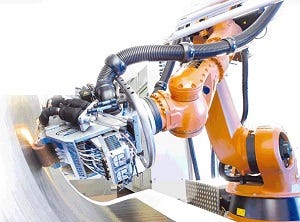A rapid curing epoxy prepreg that allows automotive components and sports goods to be press-cured in a two-minute cycle at 150°C (80 bar pressure) will debut at the JEC Show in Paris this month.
March 7, 2014
A rapid curing epoxy prepreg that allows automotive components and sports goods to be press-cured in a two-minute cycle at 150°C (80 bar pressure) will debut at the JEC Show in Paris this month.
HexPly M77 from Hexcel (Stamford, CT) enables prepregs to be cut into precise shapes using a laser cutter. The individual plies can then be oriented, assembled and consolidated into a flat preform by robot. Once in the mold HexPly M77 has an optimized gel time that allows the resin to flow into the contours to produce the precise geometries required. The high Tg of 125°C means that cured parts can be demolded while hot for a faster production cycle.
This rapid-curing product, with a 6-week outlife at room temperature, is available in various forms including unidirectional or woven reinforcements and heavy tow fibers. It is also supplied as HexMC, Hexcel's high performance carbon fiber/epoxy compound developed specifically for compression molding processes. HexMC is said to be ideal for the series production of complex shaped parts with thickness variation, sharp angles or parts that require inserts to be integrated into the molding process such as screw threads.
|
Automated fiber placement process employed to fabricate aircraft fuselage panel demonstrator. |
Also at JEC, Hexcel is launching HexPly M92, a prepreg that combines all the benefits achieved individually with other 125°C curing epoxy resins in one new "multi-purpose" system. These include excellent hot wet Tg performance of 115°C, allowing HexPly M92 to operate at higher service temperatures from a lower cost 125°C cure. The system is also self-adhesive to honeycomb, making it suitable for sandwich structures as well as monolithic components. Other benefits include high toughness, fire resistance, low exotherm, a long out/tack life and the ability to cure by vacuum bag. HexPly M92 is available in a wide range of prepreg forms (woven and UD tape).
Aerospace cost savings
Hexcel will also display a helicopter rotor hub cap fairing manufactured by Airbus Helicopters. This oven-cured part is a honeycomb sandwich structure in which the prepreg is bonded directly to the non-metallic core, without any additional adhesive. Airbus Helicopters estimates that weight savings of 8- 15% will be achieved by manufacturing this part from HexPly M92, depending on the helicopter type.
Hexcel is also introducing advanced dry carbon fiber reinforcements that combine the benefits of automated processing with the cost-effectiveness of out-of-autoclave infusion technologies. HiTape allows preforms to be manufactured in a fully automated lay-up process, with high deposition rates. Parts produced with HiTape and Hexcel's HexFlow infusion resins can be up to 30-mm thick with a 58-60% fiber volume content, resulting in mechanical properties that are as high as those achieved with primary structure prepregs.
To demonstrate the potential of HiTape for cost and cycle efficient next generation aircraft primary structures, Hexcel has worked with Aerolia SAS and Coriolis Composites (Quéven, France) to design and manufacture an aircraft fuselage panel demonstrator that will be on display at JEC. Aerolia SAS is a major world player in the design and production of aircraft equipped fuselages. Coriolis Composites is a leader in the development and manufacture of automated fiber placement processes for composites.
The fuselage panel is a self-stiffened skin that was designed by Aerolia to meet the mechanical performance requirements for primary structures. Coriolis Composites developed the dry automated fiber placement process for the full scale fuselage skin demonstrator - and the dry preforms were made at Compositadour's facilities. The HiTape preform skin and stiffeners were infused with HexFlow RTM6 resin at Hexcel's new Applications Laboratory in Les Avenieres, close to Lyon, France, using a co-infusion process that was developed in-house.
The resulting fuselage panel demonstrates that parts made with HiTape and HexFlow RTM6 meet the high mechanical performance requirements for primary structures, including toughness. HiTape is a cost-effective, highly automated solution for the manufacture of aircraft primary structures that enables aircraft designers to meet the cost and build rate targets for next generation aircraft, while retaining the weight-saving benefits that are achieved with prepregs.
About the Author(s)
You May Also Like



